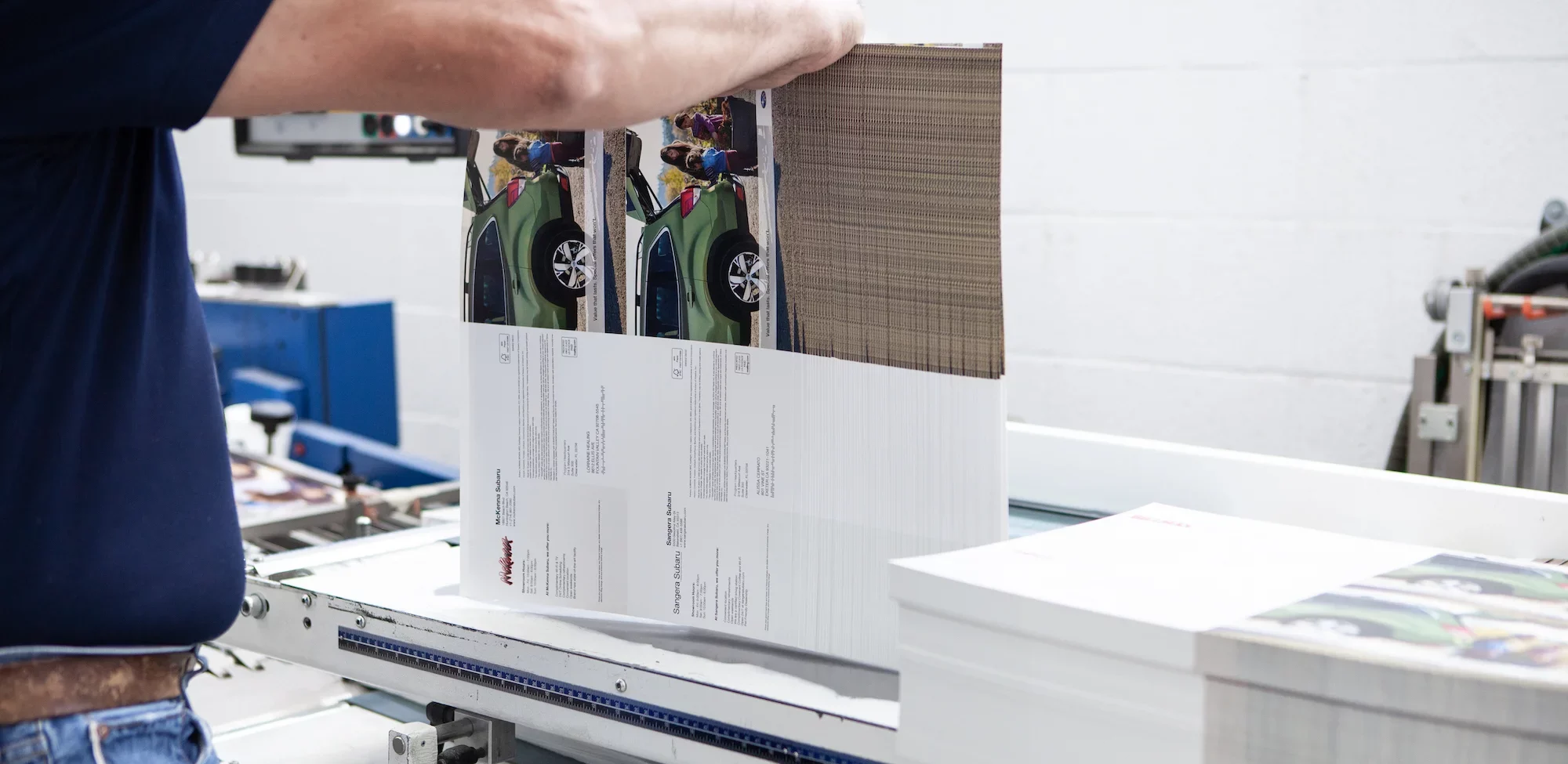Folded Self-Mailers – The Basics (and a Lot More)
By Ashley Jorgensen | March 19, 2020

When you want to grab a customer’s attention with a splashy direct mail campaign, consider a folded self-mailer.
It looks simple enough – a single folded piece of paper or cardstock – but a self-mailer is a powerful tool. Depending on your goals and budget, it may be to your advantage to go with this format for your direct mail marketing campaign.
The basic requirements
Let’s first consider the self-mailer’s dimensions (according to U.S. Postal Service) when it’s folded and sealed:
- Height: minimum of 3.5 inches and maximum of 6 inches.
- Length: minimum of 5 inches and maximum of 10.5 inches
- Thickness: minimum of .007 inch and maximum of 1/4 inch
Note: a minimum of .009 inch is okay if the height goes over 4-1/4 inches or if the length is greater than 6 inches.
- Maximum weight: 3 ounces
Self-mailer panels
Every self-mailer is made up of panels (the sections created when a sheet of paper is folded). To get the total number of panels, count each two-sided section created by the folds to get one panel. Don’t forget to include the front and back.
You can have a maximum of 12 panels, but there are exceptions (see section 3.14.3 of the Postal Explorer.)
The outside panels produced by the fold must be equal or almost equal in size.
The non-address side or back of the mailer is the last folded panel of the mailpiece. The back panel’s open edge must be at the top or within 1 inch of the top or around the edge of the mailpiece.
The last folded edge must be positioned at the bottom of the self-mailer unless it is an oblong piece. Oblong pieces are covered below.
Self-mailer flaps
Some self-mailers have flaps, which are created when the last panel is folded over and attached to the unaddressed side of the piece. Below are some basic standards and requirements for flaps:
- The flap must be at least 1-1/2 inches when measured from the top of the mailpiece.
- The flap’s folded edge must be in line with the top of the mailpiece and finish 1 inch or more above the bottom edge. However, there are exceptions (see section 3.14.3f4 of the Postal Explorer).
- All flaps must be secured by tabs or glue spots/lines.
- Die-cut shapes should be secured with tabs or glue spots/lines.
Tabbing guidelines
Okay, with those measurements out of the way, now what?
Well, you’ll need to figure out how to seal the edges of your mailer to give it a safe passage through the USPS processing equipment. This also enhances how a customer experiences your mailer.
Our comprehensive tabbing regulations post covers how your mailer can be sealed. Your choices are glue (lines or spots) or tabs and seals (paper, translucent paper, vinyl, or plastic). The post also illustrates folding options including bi-fold and tri-fold.
How to wow with self-mailers
With multiple tabbed or glued folded panels, you have more real estate to engage your audience, tell them about your offer and what you want them to do. But that doesn’t mean that anything goes.
These tips will help you create a folded self-mailer that meets your marketing objectives.
1. Let it flow
Or rather, make “it” – your sales pitch – flow as the piece unfolds.
Your overall theme for the mailer should be consistent, starting with the front panel. This is where your recipients decide whether to open the mailpiece. The front doesn’t need to be dramatic. But it should spark enough curiosity to bring them into the offer and to get them to read on to the next panel.
No matter what folding concept you choose – for example, a trifold, iron cross, or elaborate twist fold – it shouldn’t be a gimmick. Instead, it should be an integral part of your campaign.
Every panel and spread should have its own function. Early on in your planning, draw up a list of the points you want to make, as well as what images and graphics you have to support them. Create a mock layout showing what goes on which panels and in the right relationships.
2. Make an immediate visual impact
Some direct mail marketers say, “It’s copy that sells, not the design … but it’s the design that sells the copy.”
This means that even persuasive copy that’s well-written, loaded with benefits (not features), won’t be read if it’s not presented right.
People process visual information faster than words. So, how the piece looks is a crucial factor in standing out. Full-color, high-resolution photos, charts, and graphics on glossy or matte stock attract interest.
Your images should illustrate – as much as possible – the product or service being marketed. People and actions look great, especially when framed wisely by white or negative space on your mailer. But remember: Attractive or dazzling pictures are not decorations. They’re there to support your offer and copy.
3. Pack a punch with words
Your copy should be a quick read. This means short headlines and sentences, and an easily found call to action so customers understand your overall message or offer.
This helps move them from one panel to the next as they think about how your service or product will benefit them. Also, specifics outsell generalization: don’t waste their time by making them search everywhere for the details of your offer.
Readability should outweigh even some considerations like style. Avoid using text reversed out of a dark color, and carefully look at the point size of any sans serif typefaces.
4. Good markets for self-mailers
Retailers are big users of self-mailers, along with telecom companies, healthcare, startups … they all need to convey a fair amount of information but without a lot of (or even any) personalization.
Some common offers to promote include:
- Special events, grand openings, open houses, conferences
- VIP/Friends-and-Family sales, special sales
- Coupons – lots of coupons – for dentists, audiologists, pizza shops … you get the idea.
Wrapping it up
Self-mailers should reflect your overall marketing message and not sacrifice value for creativity. Revealing a message one panel or spread at a time builds a case in the customer’s mind and ultimately helps them “What’s in it for me?”
We can help you manage the entire process of your self-mailer campaign – from design to production through production and mailing through the USPS. Just give us a call at 800-645-6659 or reach out here.


